Governance and Management: Clinical Governance Report and Analysis
VerifiedAdded on 2022/09/28
|11
|3073
|24
Report
AI Summary
This report delves into the critical role of clinical governance in ensuring quality and safety within healthcare settings. It begins by defining clinical governance and its relationship to governance and management, emphasizing its origins and evolution as a framework for improving patient care. The report then outlines specific actions undertaken to monitor and enhance quality, including clinical auditing, staff training and development, research and clinical effectiveness, risk management, staff management, patient engagement, and information management. A significant portion of the report analyzes the relationship between governance and management within the context of clinical governance, particularly focusing on its application in Iwi primary health care. Finally, the report includes a personal reflection on the challenges and issues encountered in implementing clinical governance, such as policy updates, conflicts of interest, and the impact of cultural factors, providing a comprehensive overview of the subject.
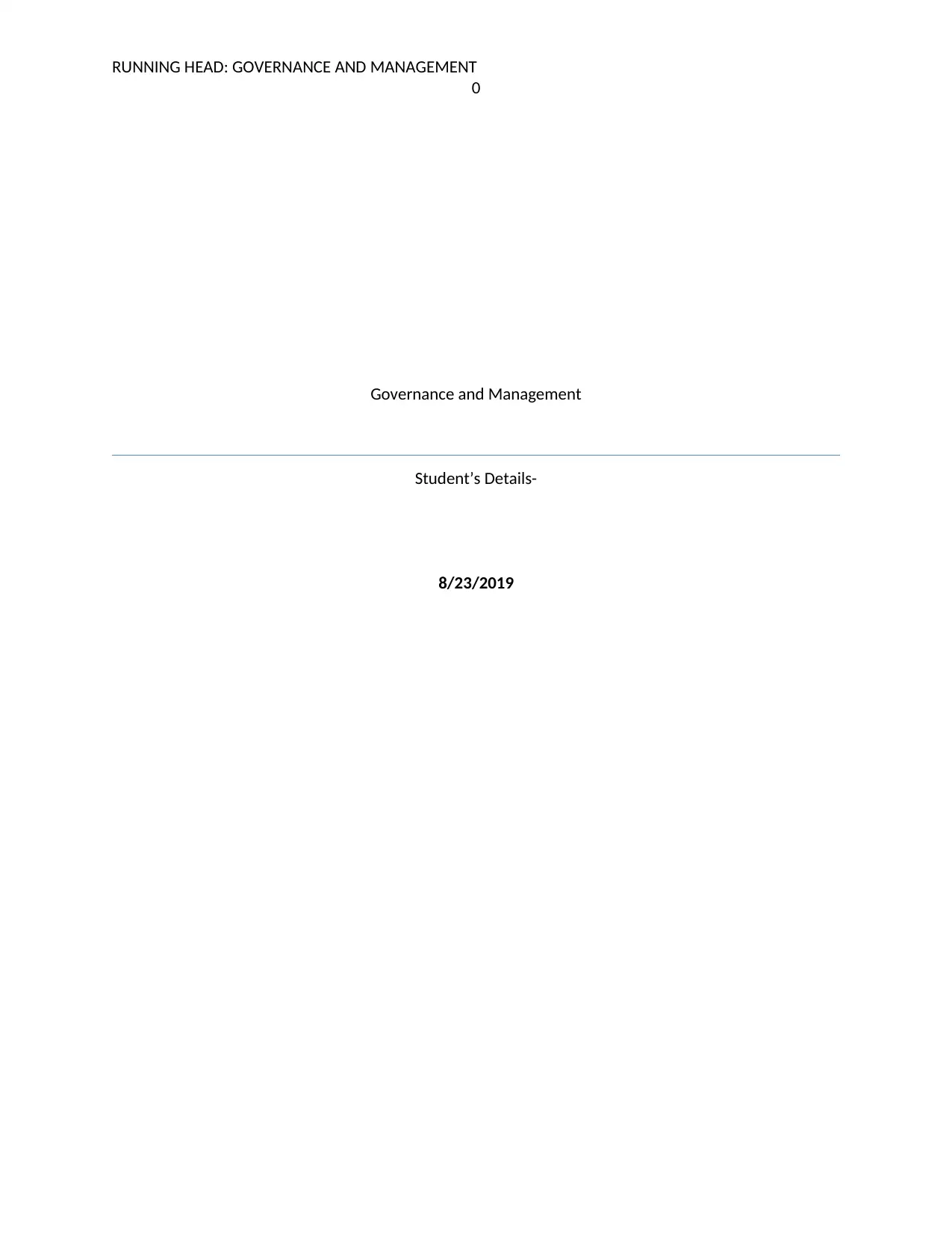
RUNNING HEAD: GOVERNANCE AND MANAGEMENT
0
Governance and Management
Student’s Details-
8/23/2019
0
Governance and Management
Student’s Details-
8/23/2019
Paraphrase This Document
Need a fresh take? Get an instant paraphrase of this document with our AI Paraphraser
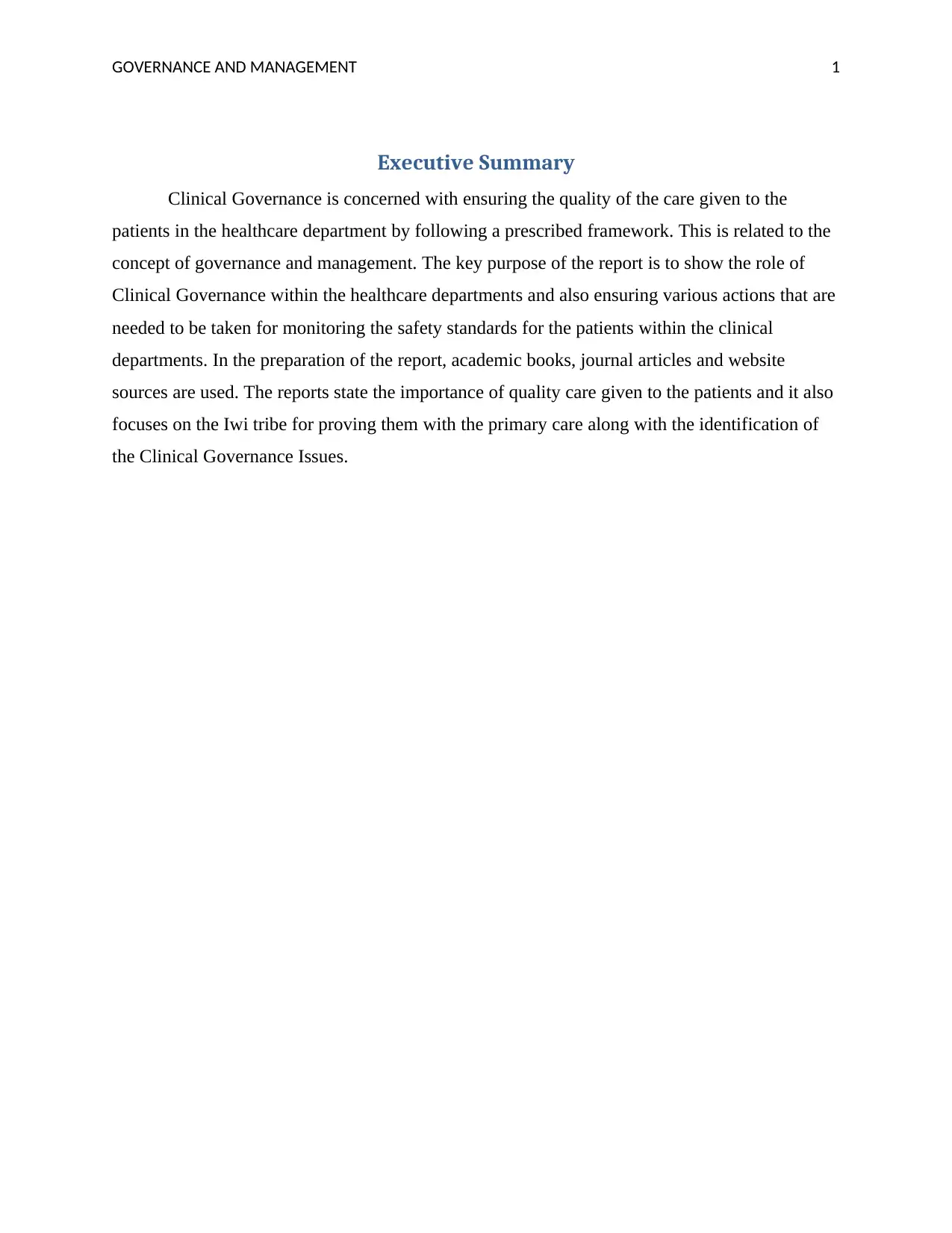
GOVERNANCE AND MANAGEMENT 1
Executive Summary
Clinical Governance is concerned with ensuring the quality of the care given to the
patients in the healthcare department by following a prescribed framework. This is related to the
concept of governance and management. The key purpose of the report is to show the role of
Clinical Governance within the healthcare departments and also ensuring various actions that are
needed to be taken for monitoring the safety standards for the patients within the clinical
departments. In the preparation of the report, academic books, journal articles and website
sources are used. The reports state the importance of quality care given to the patients and it also
focuses on the Iwi tribe for proving them with the primary care along with the identification of
the Clinical Governance Issues.
Executive Summary
Clinical Governance is concerned with ensuring the quality of the care given to the
patients in the healthcare department by following a prescribed framework. This is related to the
concept of governance and management. The key purpose of the report is to show the role of
Clinical Governance within the healthcare departments and also ensuring various actions that are
needed to be taken for monitoring the safety standards for the patients within the clinical
departments. In the preparation of the report, academic books, journal articles and website
sources are used. The reports state the importance of quality care given to the patients and it also
focuses on the Iwi tribe for proving them with the primary care along with the identification of
the Clinical Governance Issues.
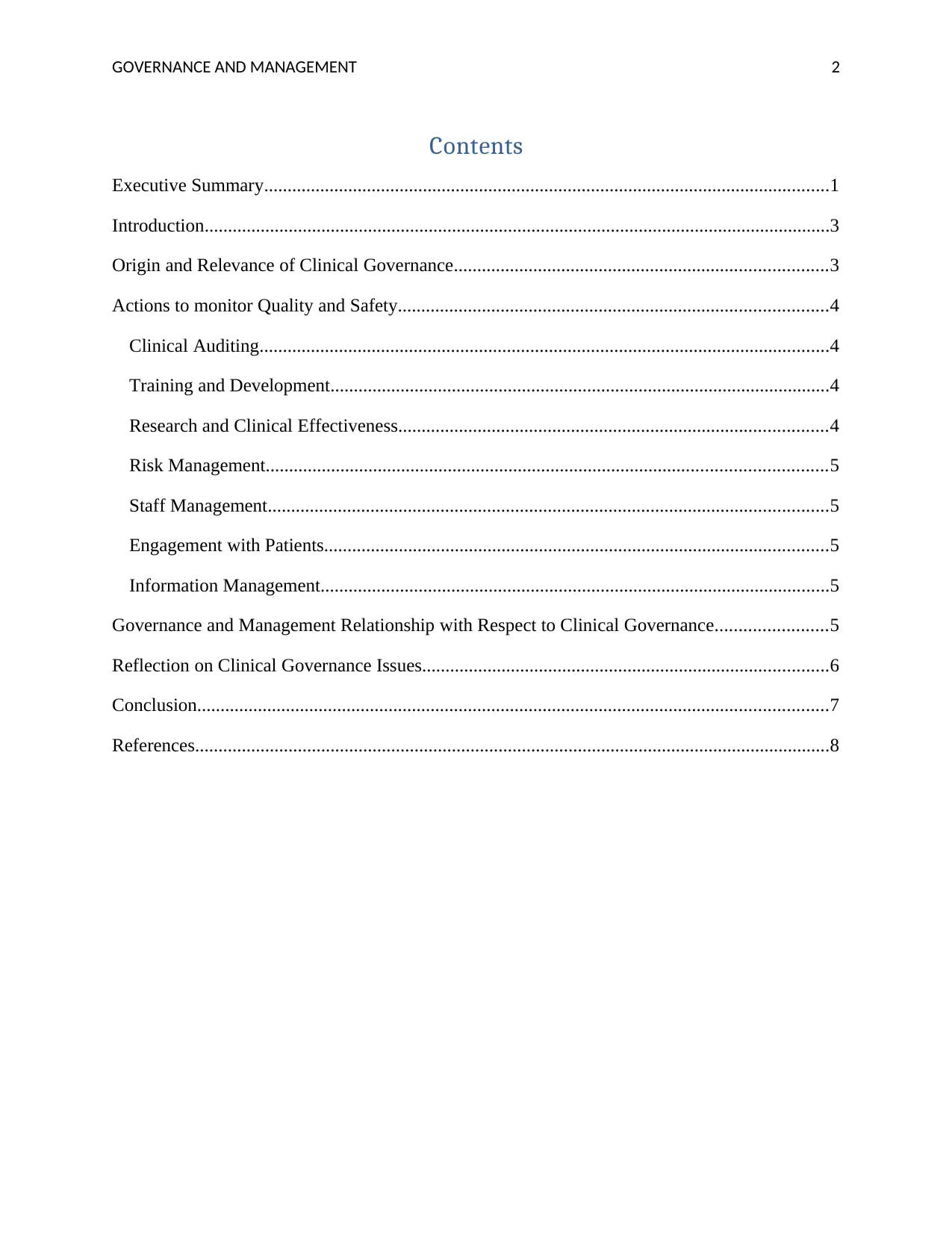
GOVERNANCE AND MANAGEMENT 2
Contents
Executive Summary.........................................................................................................................1
Introduction......................................................................................................................................3
Origin and Relevance of Clinical Governance................................................................................3
Actions to monitor Quality and Safety............................................................................................4
Clinical Auditing..........................................................................................................................4
Training and Development...........................................................................................................4
Research and Clinical Effectiveness............................................................................................4
Risk Management........................................................................................................................5
Staff Management........................................................................................................................5
Engagement with Patients............................................................................................................5
Information Management.............................................................................................................5
Governance and Management Relationship with Respect to Clinical Governance........................5
Reflection on Clinical Governance Issues.......................................................................................6
Conclusion.......................................................................................................................................7
References........................................................................................................................................8
Contents
Executive Summary.........................................................................................................................1
Introduction......................................................................................................................................3
Origin and Relevance of Clinical Governance................................................................................3
Actions to monitor Quality and Safety............................................................................................4
Clinical Auditing..........................................................................................................................4
Training and Development...........................................................................................................4
Research and Clinical Effectiveness............................................................................................4
Risk Management........................................................................................................................5
Staff Management........................................................................................................................5
Engagement with Patients............................................................................................................5
Information Management.............................................................................................................5
Governance and Management Relationship with Respect to Clinical Governance........................5
Reflection on Clinical Governance Issues.......................................................................................6
Conclusion.......................................................................................................................................7
References........................................................................................................................................8
⊘ This is a preview!⊘
Do you want full access?
Subscribe today to unlock all pages.

Trusted by 1+ million students worldwide
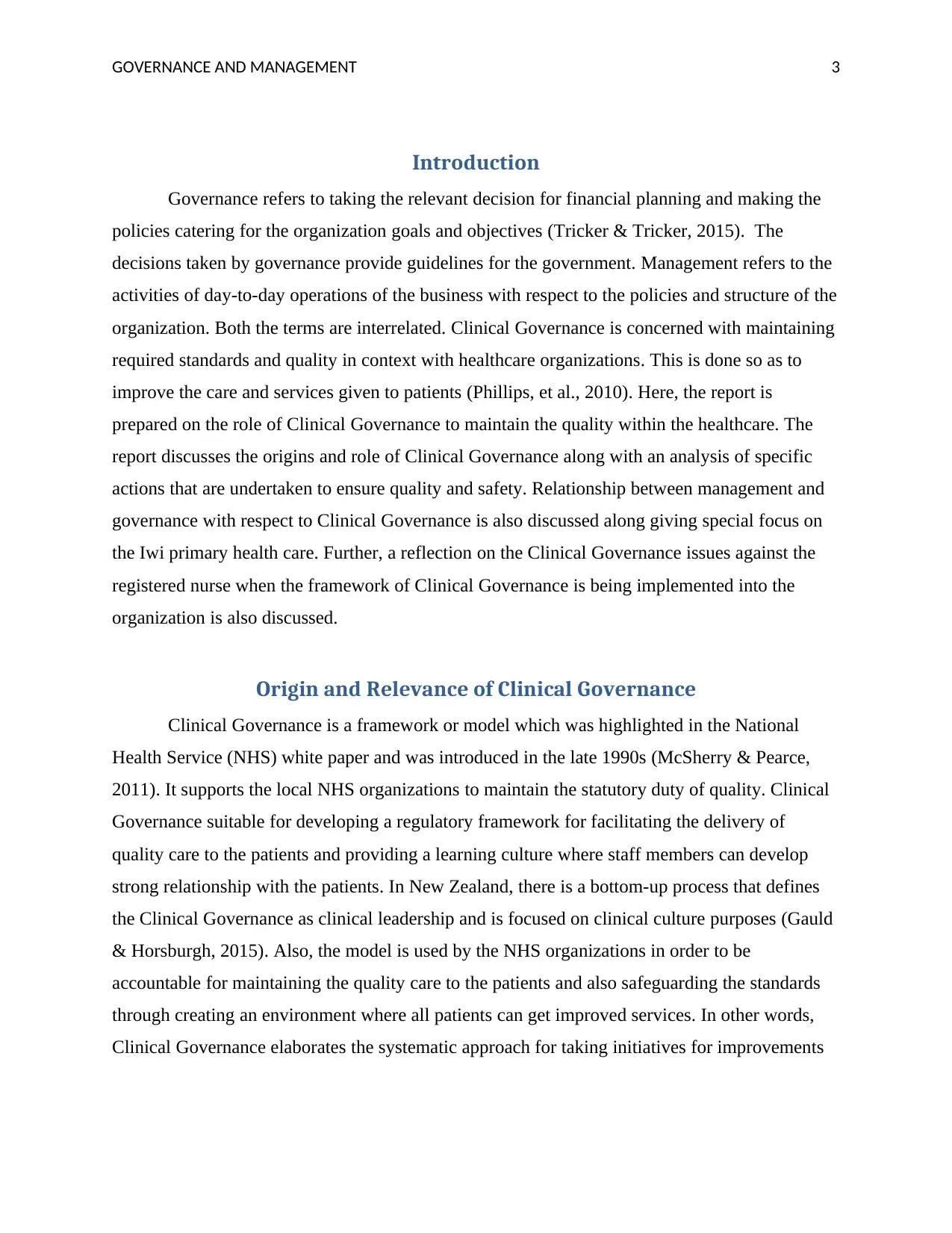
GOVERNANCE AND MANAGEMENT 3
Introduction
Governance refers to taking the relevant decision for financial planning and making the
policies catering for the organization goals and objectives (Tricker & Tricker, 2015). The
decisions taken by governance provide guidelines for the government. Management refers to the
activities of day-to-day operations of the business with respect to the policies and structure of the
organization. Both the terms are interrelated. Clinical Governance is concerned with maintaining
required standards and quality in context with healthcare organizations. This is done so as to
improve the care and services given to patients (Phillips, et al., 2010). Here, the report is
prepared on the role of Clinical Governance to maintain the quality within the healthcare. The
report discusses the origins and role of Clinical Governance along with an analysis of specific
actions that are undertaken to ensure quality and safety. Relationship between management and
governance with respect to Clinical Governance is also discussed along giving special focus on
the Iwi primary health care. Further, a reflection on the Clinical Governance issues against the
registered nurse when the framework of Clinical Governance is being implemented into the
organization is also discussed.
Origin and Relevance of Clinical Governance
Clinical Governance is a framework or model which was highlighted in the National
Health Service (NHS) white paper and was introduced in the late 1990s (McSherry & Pearce,
2011). It supports the local NHS organizations to maintain the statutory duty of quality. Clinical
Governance suitable for developing a regulatory framework for facilitating the delivery of
quality care to the patients and providing a learning culture where staff members can develop
strong relationship with the patients. In New Zealand, there is a bottom-up process that defines
the Clinical Governance as clinical leadership and is focused on clinical culture purposes (Gauld
& Horsburgh, 2015). Also, the model is used by the NHS organizations in order to be
accountable for maintaining the quality care to the patients and also safeguarding the standards
through creating an environment where all patients can get improved services. In other words,
Clinical Governance elaborates the systematic approach for taking initiatives for improvements
Introduction
Governance refers to taking the relevant decision for financial planning and making the
policies catering for the organization goals and objectives (Tricker & Tricker, 2015). The
decisions taken by governance provide guidelines for the government. Management refers to the
activities of day-to-day operations of the business with respect to the policies and structure of the
organization. Both the terms are interrelated. Clinical Governance is concerned with maintaining
required standards and quality in context with healthcare organizations. This is done so as to
improve the care and services given to patients (Phillips, et al., 2010). Here, the report is
prepared on the role of Clinical Governance to maintain the quality within the healthcare. The
report discusses the origins and role of Clinical Governance along with an analysis of specific
actions that are undertaken to ensure quality and safety. Relationship between management and
governance with respect to Clinical Governance is also discussed along giving special focus on
the Iwi primary health care. Further, a reflection on the Clinical Governance issues against the
registered nurse when the framework of Clinical Governance is being implemented into the
organization is also discussed.
Origin and Relevance of Clinical Governance
Clinical Governance is a framework or model which was highlighted in the National
Health Service (NHS) white paper and was introduced in the late 1990s (McSherry & Pearce,
2011). It supports the local NHS organizations to maintain the statutory duty of quality. Clinical
Governance suitable for developing a regulatory framework for facilitating the delivery of
quality care to the patients and providing a learning culture where staff members can develop
strong relationship with the patients. In New Zealand, there is a bottom-up process that defines
the Clinical Governance as clinical leadership and is focused on clinical culture purposes (Gauld
& Horsburgh, 2015). Also, the model is used by the NHS organizations in order to be
accountable for maintaining the quality care to the patients and also safeguarding the standards
through creating an environment where all patients can get improved services. In other words,
Clinical Governance elaborates the systematic approach for taking initiatives for improvements
Paraphrase This Document
Need a fresh take? Get an instant paraphrase of this document with our AI Paraphraser
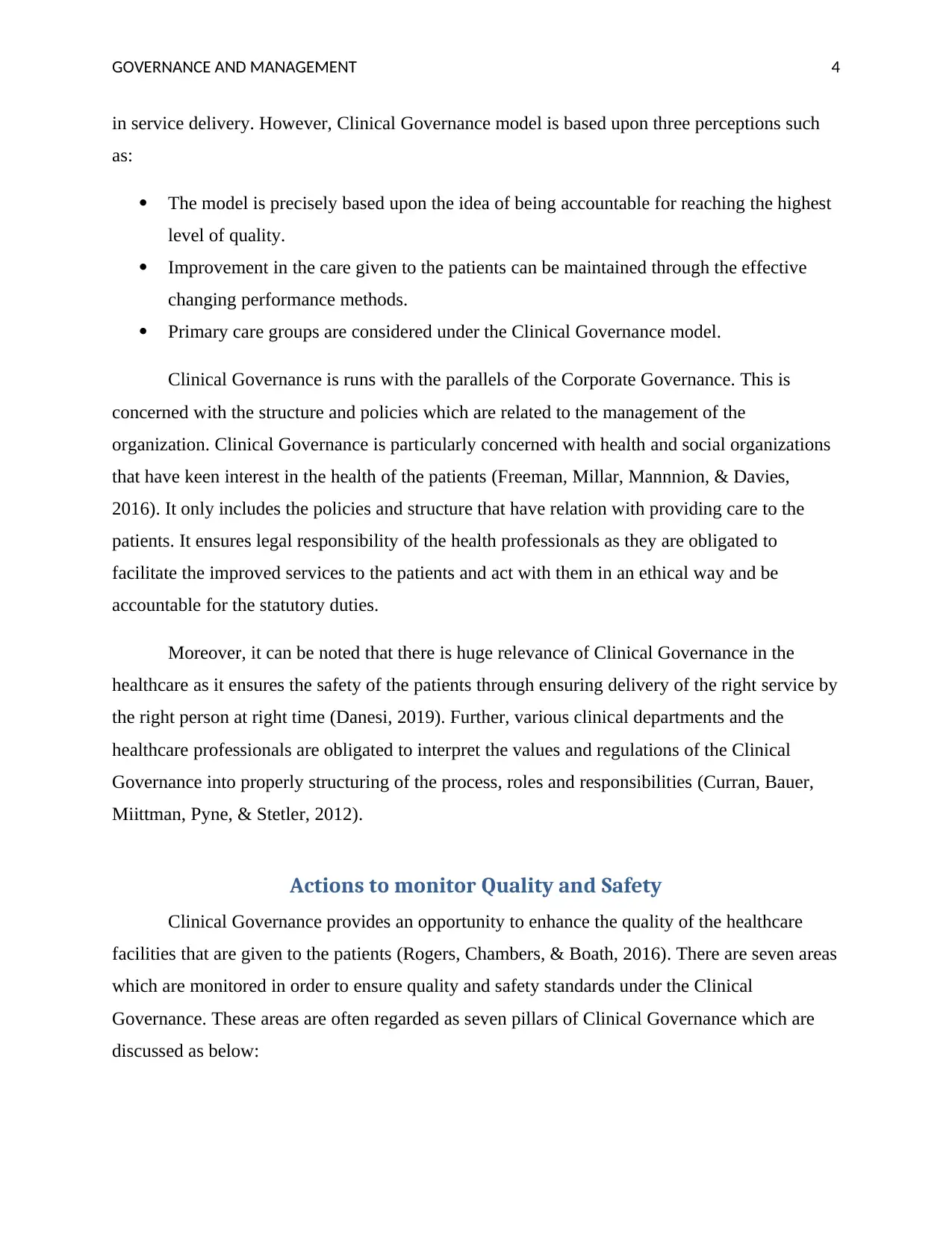
GOVERNANCE AND MANAGEMENT 4
in service delivery. However, Clinical Governance model is based upon three perceptions such
as:
The model is precisely based upon the idea of being accountable for reaching the highest
level of quality.
Improvement in the care given to the patients can be maintained through the effective
changing performance methods.
Primary care groups are considered under the Clinical Governance model.
Clinical Governance is runs with the parallels of the Corporate Governance. This is
concerned with the structure and policies which are related to the management of the
organization. Clinical Governance is particularly concerned with health and social organizations
that have keen interest in the health of the patients (Freeman, Millar, Mannnion, & Davies,
2016). It only includes the policies and structure that have relation with providing care to the
patients. It ensures legal responsibility of the health professionals as they are obligated to
facilitate the improved services to the patients and act with them in an ethical way and be
accountable for the statutory duties.
Moreover, it can be noted that there is huge relevance of Clinical Governance in the
healthcare as it ensures the safety of the patients through ensuring delivery of the right service by
the right person at right time (Danesi, 2019). Further, various clinical departments and the
healthcare professionals are obligated to interpret the values and regulations of the Clinical
Governance into properly structuring of the process, roles and responsibilities (Curran, Bauer,
Miittman, Pyne, & Stetler, 2012).
Actions to monitor Quality and Safety
Clinical Governance provides an opportunity to enhance the quality of the healthcare
facilities that are given to the patients (Rogers, Chambers, & Boath, 2016). There are seven areas
which are monitored in order to ensure quality and safety standards under the Clinical
Governance. These areas are often regarded as seven pillars of Clinical Governance which are
discussed as below:
in service delivery. However, Clinical Governance model is based upon three perceptions such
as:
The model is precisely based upon the idea of being accountable for reaching the highest
level of quality.
Improvement in the care given to the patients can be maintained through the effective
changing performance methods.
Primary care groups are considered under the Clinical Governance model.
Clinical Governance is runs with the parallels of the Corporate Governance. This is
concerned with the structure and policies which are related to the management of the
organization. Clinical Governance is particularly concerned with health and social organizations
that have keen interest in the health of the patients (Freeman, Millar, Mannnion, & Davies,
2016). It only includes the policies and structure that have relation with providing care to the
patients. It ensures legal responsibility of the health professionals as they are obligated to
facilitate the improved services to the patients and act with them in an ethical way and be
accountable for the statutory duties.
Moreover, it can be noted that there is huge relevance of Clinical Governance in the
healthcare as it ensures the safety of the patients through ensuring delivery of the right service by
the right person at right time (Danesi, 2019). Further, various clinical departments and the
healthcare professionals are obligated to interpret the values and regulations of the Clinical
Governance into properly structuring of the process, roles and responsibilities (Curran, Bauer,
Miittman, Pyne, & Stetler, 2012).
Actions to monitor Quality and Safety
Clinical Governance provides an opportunity to enhance the quality of the healthcare
facilities that are given to the patients (Rogers, Chambers, & Boath, 2016). There are seven areas
which are monitored in order to ensure quality and safety standards under the Clinical
Governance. These areas are often regarded as seven pillars of Clinical Governance which are
discussed as below:
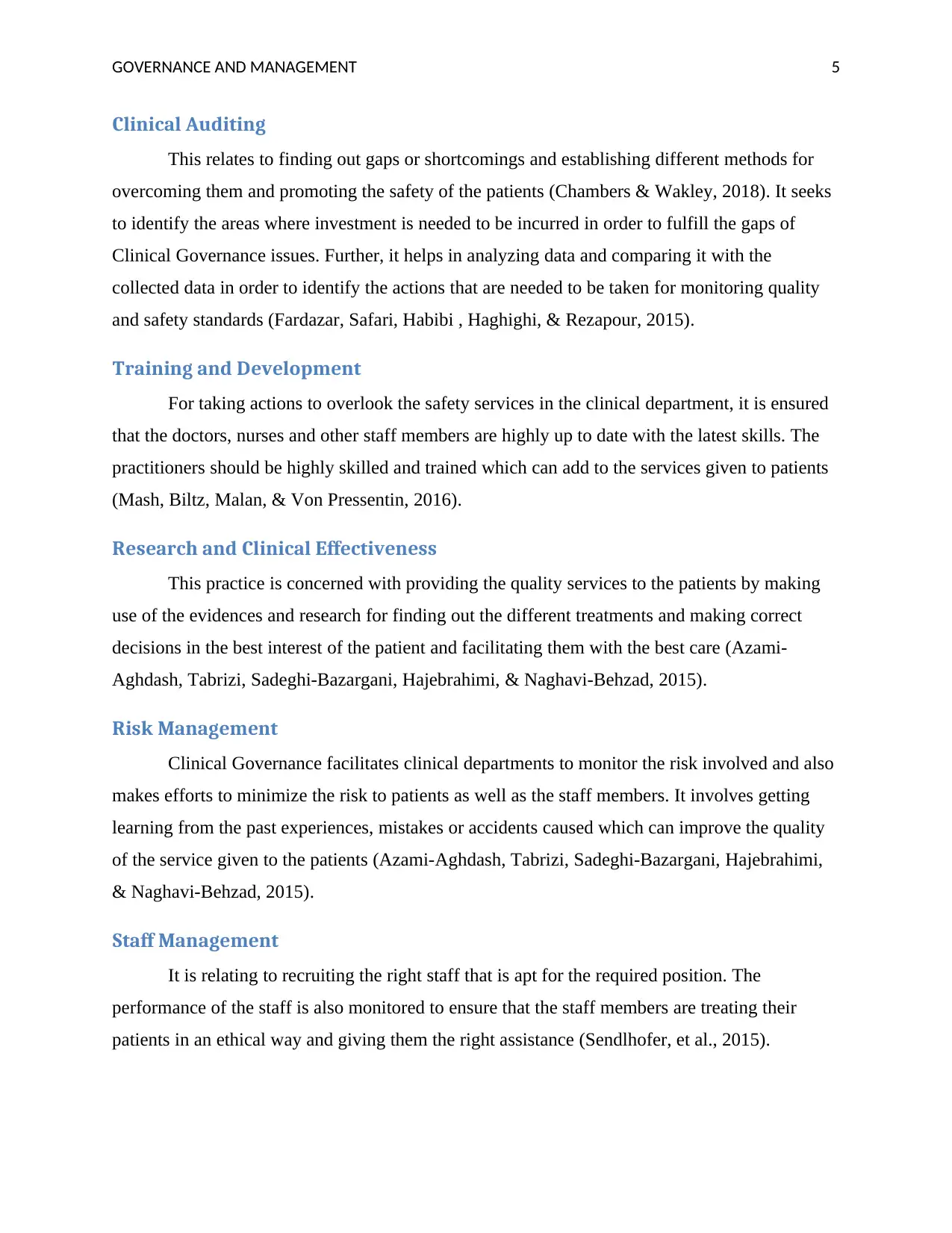
GOVERNANCE AND MANAGEMENT 5
Clinical Auditing
This relates to finding out gaps or shortcomings and establishing different methods for
overcoming them and promoting the safety of the patients (Chambers & Wakley, 2018). It seeks
to identify the areas where investment is needed to be incurred in order to fulfill the gaps of
Clinical Governance issues. Further, it helps in analyzing data and comparing it with the
collected data in order to identify the actions that are needed to be taken for monitoring quality
and safety standards (Fardazar, Safari, Habibi , Haghighi, & Rezapour, 2015).
Training and Development
For taking actions to overlook the safety services in the clinical department, it is ensured
that the doctors, nurses and other staff members are highly up to date with the latest skills. The
practitioners should be highly skilled and trained which can add to the services given to patients
(Mash, Biltz, Malan, & Von Pressentin, 2016).
Research and Clinical Effectiveness
This practice is concerned with providing the quality services to the patients by making
use of the evidences and research for finding out the different treatments and making correct
decisions in the best interest of the patient and facilitating them with the best care (Azami-
Aghdash, Tabrizi, Sadeghi-Bazargani, Hajebrahimi, & Naghavi-Behzad, 2015).
Risk Management
Clinical Governance facilitates clinical departments to monitor the risk involved and also
makes efforts to minimize the risk to patients as well as the staff members. It involves getting
learning from the past experiences, mistakes or accidents caused which can improve the quality
of the service given to the patients (Azami-Aghdash, Tabrizi, Sadeghi-Bazargani, Hajebrahimi,
& Naghavi-Behzad, 2015).
Staff Management
It is relating to recruiting the right staff that is apt for the required position. The
performance of the staff is also monitored to ensure that the staff members are treating their
patients in an ethical way and giving them the right assistance (Sendlhofer, et al., 2015).
Clinical Auditing
This relates to finding out gaps or shortcomings and establishing different methods for
overcoming them and promoting the safety of the patients (Chambers & Wakley, 2018). It seeks
to identify the areas where investment is needed to be incurred in order to fulfill the gaps of
Clinical Governance issues. Further, it helps in analyzing data and comparing it with the
collected data in order to identify the actions that are needed to be taken for monitoring quality
and safety standards (Fardazar, Safari, Habibi , Haghighi, & Rezapour, 2015).
Training and Development
For taking actions to overlook the safety services in the clinical department, it is ensured
that the doctors, nurses and other staff members are highly up to date with the latest skills. The
practitioners should be highly skilled and trained which can add to the services given to patients
(Mash, Biltz, Malan, & Von Pressentin, 2016).
Research and Clinical Effectiveness
This practice is concerned with providing the quality services to the patients by making
use of the evidences and research for finding out the different treatments and making correct
decisions in the best interest of the patient and facilitating them with the best care (Azami-
Aghdash, Tabrizi, Sadeghi-Bazargani, Hajebrahimi, & Naghavi-Behzad, 2015).
Risk Management
Clinical Governance facilitates clinical departments to monitor the risk involved and also
makes efforts to minimize the risk to patients as well as the staff members. It involves getting
learning from the past experiences, mistakes or accidents caused which can improve the quality
of the service given to the patients (Azami-Aghdash, Tabrizi, Sadeghi-Bazargani, Hajebrahimi,
& Naghavi-Behzad, 2015).
Staff Management
It is relating to recruiting the right staff that is apt for the required position. The
performance of the staff is also monitored to ensure that the staff members are treating their
patients in an ethical way and giving them the right assistance (Sendlhofer, et al., 2015).
⊘ This is a preview!⊘
Do you want full access?
Subscribe today to unlock all pages.

Trusted by 1+ million students worldwide
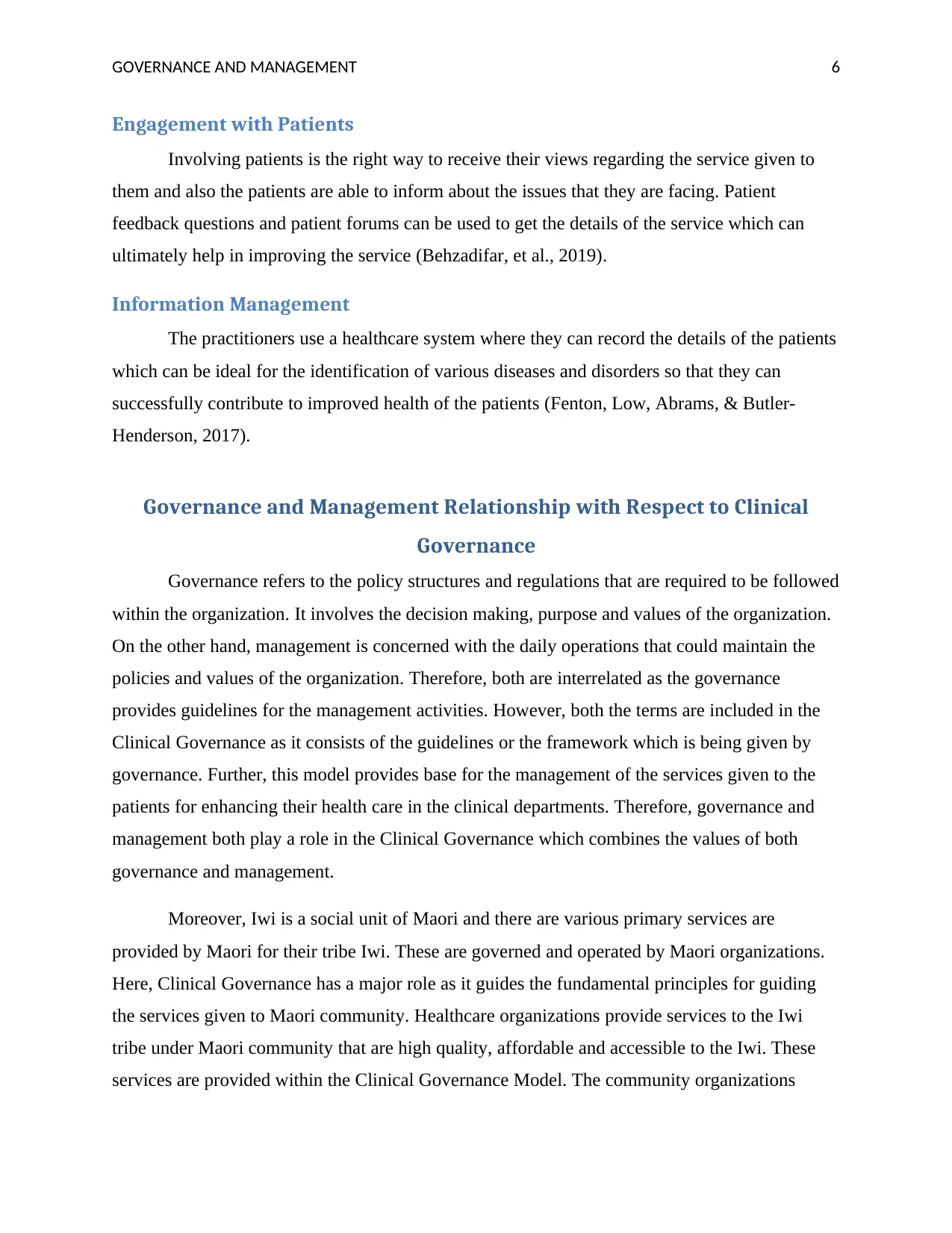
GOVERNANCE AND MANAGEMENT 6
Engagement with Patients
Involving patients is the right way to receive their views regarding the service given to
them and also the patients are able to inform about the issues that they are facing. Patient
feedback questions and patient forums can be used to get the details of the service which can
ultimately help in improving the service (Behzadifar, et al., 2019).
Information Management
The practitioners use a healthcare system where they can record the details of the patients
which can be ideal for the identification of various diseases and disorders so that they can
successfully contribute to improved health of the patients (Fenton, Low, Abrams, & Butler-
Henderson, 2017).
Governance and Management Relationship with Respect to Clinical
Governance
Governance refers to the policy structures and regulations that are required to be followed
within the organization. It involves the decision making, purpose and values of the organization.
On the other hand, management is concerned with the daily operations that could maintain the
policies and values of the organization. Therefore, both are interrelated as the governance
provides guidelines for the management activities. However, both the terms are included in the
Clinical Governance as it consists of the guidelines or the framework which is being given by
governance. Further, this model provides base for the management of the services given to the
patients for enhancing their health care in the clinical departments. Therefore, governance and
management both play a role in the Clinical Governance which combines the values of both
governance and management.
Moreover, Iwi is a social unit of Maori and there are various primary services are
provided by Maori for their tribe Iwi. These are governed and operated by Maori organizations.
Here, Clinical Governance has a major role as it guides the fundamental principles for guiding
the services given to Maori community. Healthcare organizations provide services to the Iwi
tribe under Maori community that are high quality, affordable and accessible to the Iwi. These
services are provided within the Clinical Governance Model. The community organizations
Engagement with Patients
Involving patients is the right way to receive their views regarding the service given to
them and also the patients are able to inform about the issues that they are facing. Patient
feedback questions and patient forums can be used to get the details of the service which can
ultimately help in improving the service (Behzadifar, et al., 2019).
Information Management
The practitioners use a healthcare system where they can record the details of the patients
which can be ideal for the identification of various diseases and disorders so that they can
successfully contribute to improved health of the patients (Fenton, Low, Abrams, & Butler-
Henderson, 2017).
Governance and Management Relationship with Respect to Clinical
Governance
Governance refers to the policy structures and regulations that are required to be followed
within the organization. It involves the decision making, purpose and values of the organization.
On the other hand, management is concerned with the daily operations that could maintain the
policies and values of the organization. Therefore, both are interrelated as the governance
provides guidelines for the management activities. However, both the terms are included in the
Clinical Governance as it consists of the guidelines or the framework which is being given by
governance. Further, this model provides base for the management of the services given to the
patients for enhancing their health care in the clinical departments. Therefore, governance and
management both play a role in the Clinical Governance which combines the values of both
governance and management.
Moreover, Iwi is a social unit of Maori and there are various primary services are
provided by Maori for their tribe Iwi. These are governed and operated by Maori organizations.
Here, Clinical Governance has a major role as it guides the fundamental principles for guiding
the services given to Maori community. Healthcare organizations provide services to the Iwi
tribe under Maori community that are high quality, affordable and accessible to the Iwi. These
services are provided within the Clinical Governance Model. The community organizations
Paraphrase This Document
Need a fresh take? Get an instant paraphrase of this document with our AI Paraphraser
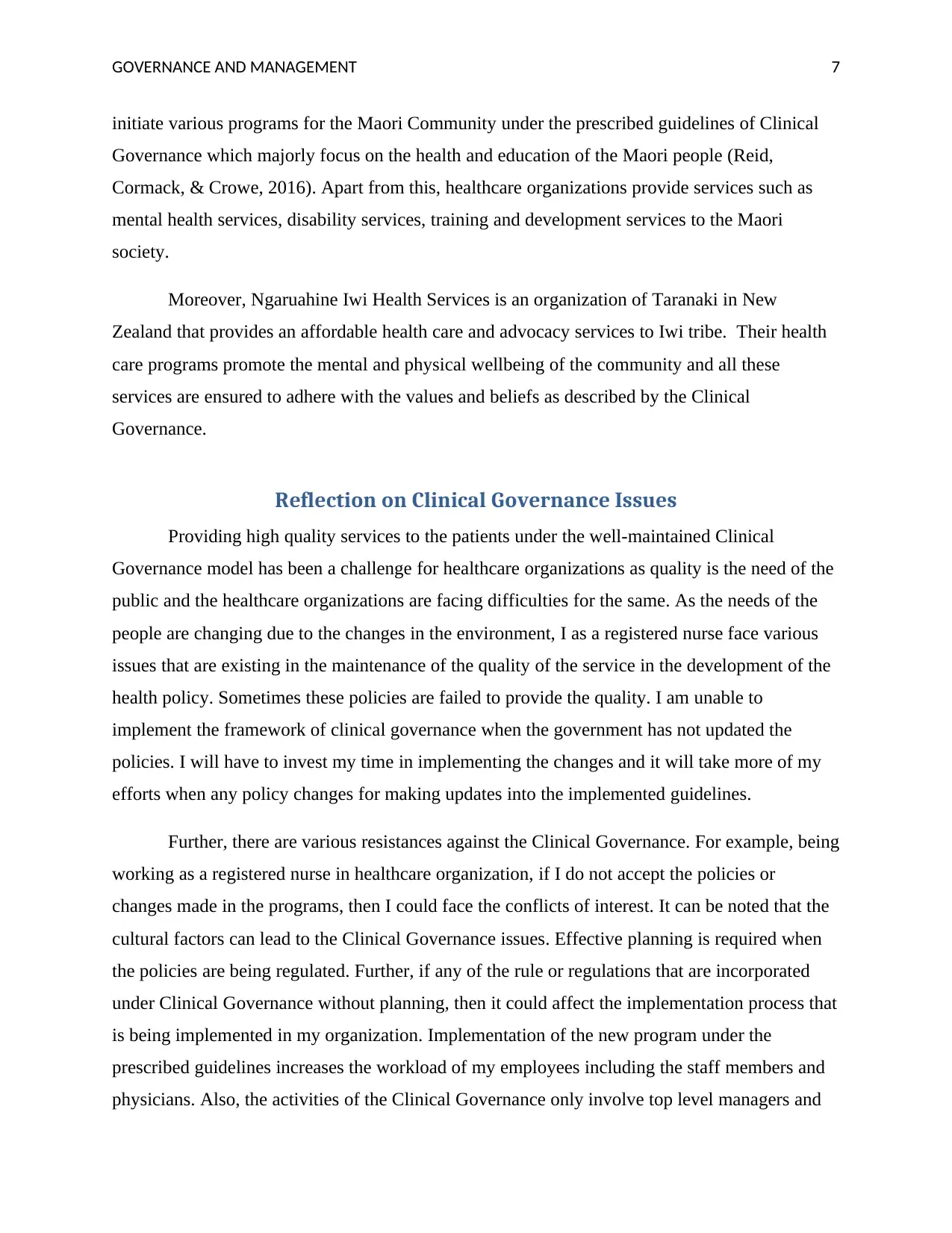
GOVERNANCE AND MANAGEMENT 7
initiate various programs for the Maori Community under the prescribed guidelines of Clinical
Governance which majorly focus on the health and education of the Maori people (Reid,
Cormack, & Crowe, 2016). Apart from this, healthcare organizations provide services such as
mental health services, disability services, training and development services to the Maori
society.
Moreover, Ngaruahine Iwi Health Services is an organization of Taranaki in New
Zealand that provides an affordable health care and advocacy services to Iwi tribe. Their health
care programs promote the mental and physical wellbeing of the community and all these
services are ensured to adhere with the values and beliefs as described by the Clinical
Governance.
Reflection on Clinical Governance Issues
Providing high quality services to the patients under the well-maintained Clinical
Governance model has been a challenge for healthcare organizations as quality is the need of the
public and the healthcare organizations are facing difficulties for the same. As the needs of the
people are changing due to the changes in the environment, I as a registered nurse face various
issues that are existing in the maintenance of the quality of the service in the development of the
health policy. Sometimes these policies are failed to provide the quality. I am unable to
implement the framework of clinical governance when the government has not updated the
policies. I will have to invest my time in implementing the changes and it will take more of my
efforts when any policy changes for making updates into the implemented guidelines.
Further, there are various resistances against the Clinical Governance. For example, being
working as a registered nurse in healthcare organization, if I do not accept the policies or
changes made in the programs, then I could face the conflicts of interest. It can be noted that the
cultural factors can lead to the Clinical Governance issues. Effective planning is required when
the policies are being regulated. Further, if any of the rule or regulations that are incorporated
under Clinical Governance without planning, then it could affect the implementation process that
is being implemented in my organization. Implementation of the new program under the
prescribed guidelines increases the workload of my employees including the staff members and
physicians. Also, the activities of the Clinical Governance only involve top level managers and
initiate various programs for the Maori Community under the prescribed guidelines of Clinical
Governance which majorly focus on the health and education of the Maori people (Reid,
Cormack, & Crowe, 2016). Apart from this, healthcare organizations provide services such as
mental health services, disability services, training and development services to the Maori
society.
Moreover, Ngaruahine Iwi Health Services is an organization of Taranaki in New
Zealand that provides an affordable health care and advocacy services to Iwi tribe. Their health
care programs promote the mental and physical wellbeing of the community and all these
services are ensured to adhere with the values and beliefs as described by the Clinical
Governance.
Reflection on Clinical Governance Issues
Providing high quality services to the patients under the well-maintained Clinical
Governance model has been a challenge for healthcare organizations as quality is the need of the
public and the healthcare organizations are facing difficulties for the same. As the needs of the
people are changing due to the changes in the environment, I as a registered nurse face various
issues that are existing in the maintenance of the quality of the service in the development of the
health policy. Sometimes these policies are failed to provide the quality. I am unable to
implement the framework of clinical governance when the government has not updated the
policies. I will have to invest my time in implementing the changes and it will take more of my
efforts when any policy changes for making updates into the implemented guidelines.
Further, there are various resistances against the Clinical Governance. For example, being
working as a registered nurse in healthcare organization, if I do not accept the policies or
changes made in the programs, then I could face the conflicts of interest. It can be noted that the
cultural factors can lead to the Clinical Governance issues. Effective planning is required when
the policies are being regulated. Further, if any of the rule or regulations that are incorporated
under Clinical Governance without planning, then it could affect the implementation process that
is being implemented in my organization. Implementation of the new program under the
prescribed guidelines increases the workload of my employees including the staff members and
physicians. Also, the activities of the Clinical Governance only involve top level managers and
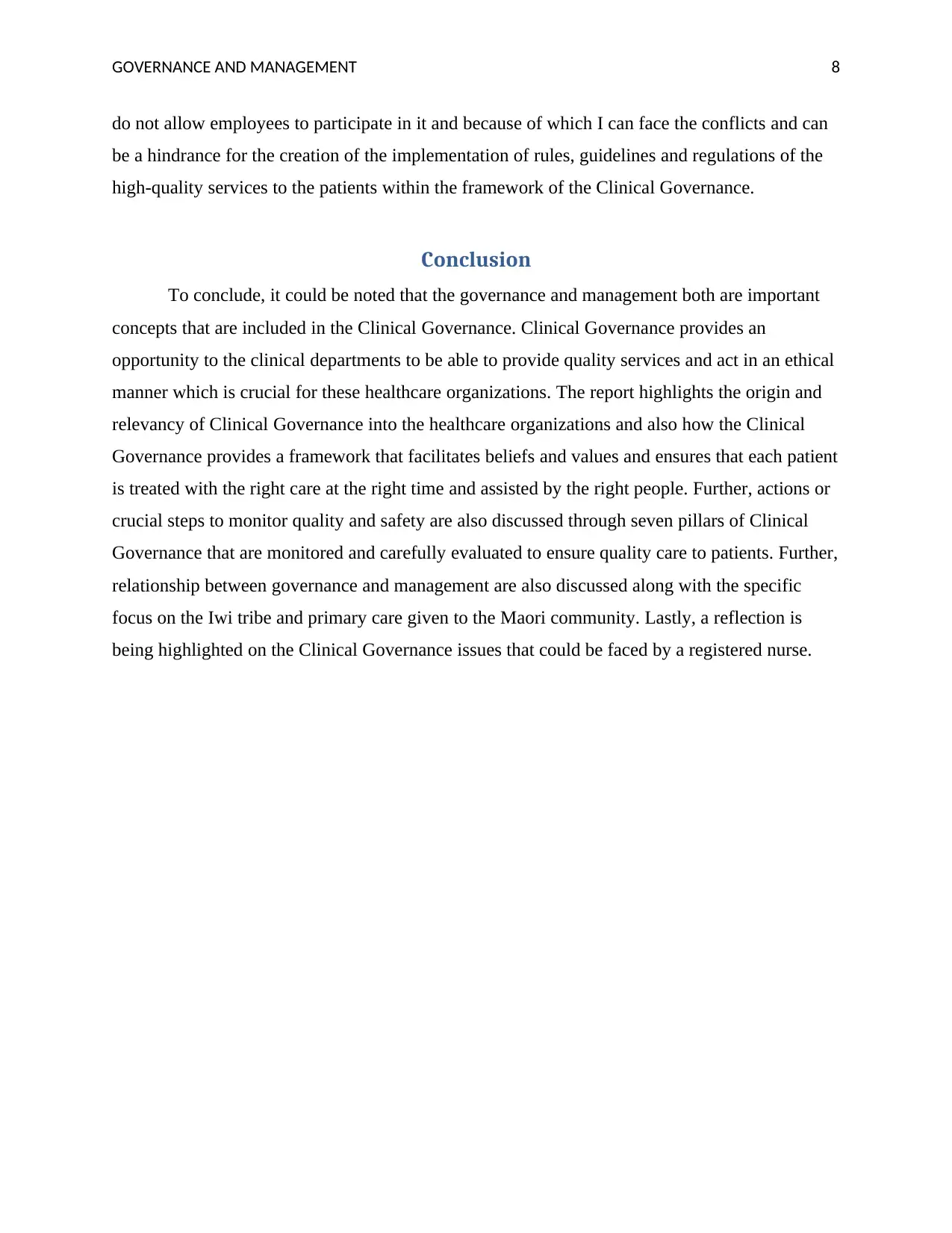
GOVERNANCE AND MANAGEMENT 8
do not allow employees to participate in it and because of which I can face the conflicts and can
be a hindrance for the creation of the implementation of rules, guidelines and regulations of the
high-quality services to the patients within the framework of the Clinical Governance.
Conclusion
To conclude, it could be noted that the governance and management both are important
concepts that are included in the Clinical Governance. Clinical Governance provides an
opportunity to the clinical departments to be able to provide quality services and act in an ethical
manner which is crucial for these healthcare organizations. The report highlights the origin and
relevancy of Clinical Governance into the healthcare organizations and also how the Clinical
Governance provides a framework that facilitates beliefs and values and ensures that each patient
is treated with the right care at the right time and assisted by the right people. Further, actions or
crucial steps to monitor quality and safety are also discussed through seven pillars of Clinical
Governance that are monitored and carefully evaluated to ensure quality care to patients. Further,
relationship between governance and management are also discussed along with the specific
focus on the Iwi tribe and primary care given to the Maori community. Lastly, a reflection is
being highlighted on the Clinical Governance issues that could be faced by a registered nurse.
do not allow employees to participate in it and because of which I can face the conflicts and can
be a hindrance for the creation of the implementation of rules, guidelines and regulations of the
high-quality services to the patients within the framework of the Clinical Governance.
Conclusion
To conclude, it could be noted that the governance and management both are important
concepts that are included in the Clinical Governance. Clinical Governance provides an
opportunity to the clinical departments to be able to provide quality services and act in an ethical
manner which is crucial for these healthcare organizations. The report highlights the origin and
relevancy of Clinical Governance into the healthcare organizations and also how the Clinical
Governance provides a framework that facilitates beliefs and values and ensures that each patient
is treated with the right care at the right time and assisted by the right people. Further, actions or
crucial steps to monitor quality and safety are also discussed through seven pillars of Clinical
Governance that are monitored and carefully evaluated to ensure quality care to patients. Further,
relationship between governance and management are also discussed along with the specific
focus on the Iwi tribe and primary care given to the Maori community. Lastly, a reflection is
being highlighted on the Clinical Governance issues that could be faced by a registered nurse.
⊘ This is a preview!⊘
Do you want full access?
Subscribe today to unlock all pages.

Trusted by 1+ million students worldwide
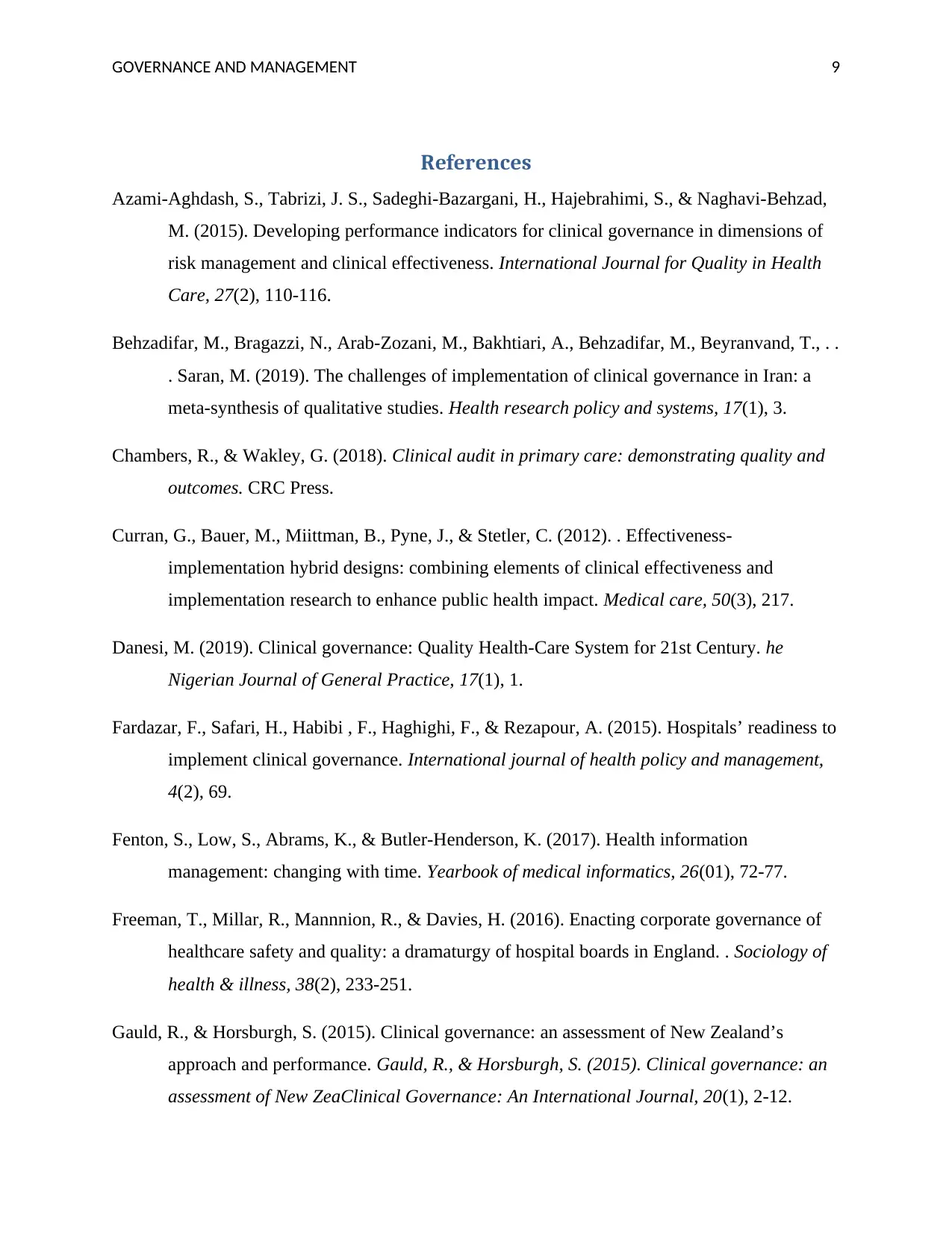
GOVERNANCE AND MANAGEMENT 9
References
Azami-Aghdash, S., Tabrizi, J. S., Sadeghi-Bazargani, H., Hajebrahimi, S., & Naghavi-Behzad,
M. (2015). Developing performance indicators for clinical governance in dimensions of
risk management and clinical effectiveness. International Journal for Quality in Health
Care, 27(2), 110-116.
Behzadifar, M., Bragazzi, N., Arab-Zozani, M., Bakhtiari, A., Behzadifar, M., Beyranvand, T., . .
. Saran, M. (2019). The challenges of implementation of clinical governance in Iran: a
meta-synthesis of qualitative studies. Health research policy and systems, 17(1), 3.
Chambers, R., & Wakley, G. (2018). Clinical audit in primary care: demonstrating quality and
outcomes. CRC Press.
Curran, G., Bauer, M., Miittman, B., Pyne, J., & Stetler, C. (2012). . Effectiveness-
implementation hybrid designs: combining elements of clinical effectiveness and
implementation research to enhance public health impact. Medical care, 50(3), 217.
Danesi, M. (2019). Clinical governance: Quality Health-Care System for 21st Century. he
Nigerian Journal of General Practice, 17(1), 1.
Fardazar, F., Safari, H., Habibi , F., Haghighi, F., & Rezapour, A. (2015). Hospitals’ readiness to
implement clinical governance. International journal of health policy and management,
4(2), 69.
Fenton, S., Low, S., Abrams, K., & Butler-Henderson, K. (2017). Health information
management: changing with time. Yearbook of medical informatics, 26(01), 72-77.
Freeman, T., Millar, R., Mannnion, R., & Davies, H. (2016). Enacting corporate governance of
healthcare safety and quality: a dramaturgy of hospital boards in England. . Sociology of
health & illness, 38(2), 233-251.
Gauld, R., & Horsburgh, S. (2015). Clinical governance: an assessment of New Zealand’s
approach and performance. Gauld, R., & Horsburgh, S. (2015). Clinical governance: an
assessment of New ZeaClinical Governance: An International Journal, 20(1), 2-12.
References
Azami-Aghdash, S., Tabrizi, J. S., Sadeghi-Bazargani, H., Hajebrahimi, S., & Naghavi-Behzad,
M. (2015). Developing performance indicators for clinical governance in dimensions of
risk management and clinical effectiveness. International Journal for Quality in Health
Care, 27(2), 110-116.
Behzadifar, M., Bragazzi, N., Arab-Zozani, M., Bakhtiari, A., Behzadifar, M., Beyranvand, T., . .
. Saran, M. (2019). The challenges of implementation of clinical governance in Iran: a
meta-synthesis of qualitative studies. Health research policy and systems, 17(1), 3.
Chambers, R., & Wakley, G. (2018). Clinical audit in primary care: demonstrating quality and
outcomes. CRC Press.
Curran, G., Bauer, M., Miittman, B., Pyne, J., & Stetler, C. (2012). . Effectiveness-
implementation hybrid designs: combining elements of clinical effectiveness and
implementation research to enhance public health impact. Medical care, 50(3), 217.
Danesi, M. (2019). Clinical governance: Quality Health-Care System for 21st Century. he
Nigerian Journal of General Practice, 17(1), 1.
Fardazar, F., Safari, H., Habibi , F., Haghighi, F., & Rezapour, A. (2015). Hospitals’ readiness to
implement clinical governance. International journal of health policy and management,
4(2), 69.
Fenton, S., Low, S., Abrams, K., & Butler-Henderson, K. (2017). Health information
management: changing with time. Yearbook of medical informatics, 26(01), 72-77.
Freeman, T., Millar, R., Mannnion, R., & Davies, H. (2016). Enacting corporate governance of
healthcare safety and quality: a dramaturgy of hospital boards in England. . Sociology of
health & illness, 38(2), 233-251.
Gauld, R., & Horsburgh, S. (2015). Clinical governance: an assessment of New Zealand’s
approach and performance. Gauld, R., & Horsburgh, S. (2015). Clinical governance: an
assessment of New ZeaClinical Governance: An International Journal, 20(1), 2-12.
Paraphrase This Document
Need a fresh take? Get an instant paraphrase of this document with our AI Paraphraser
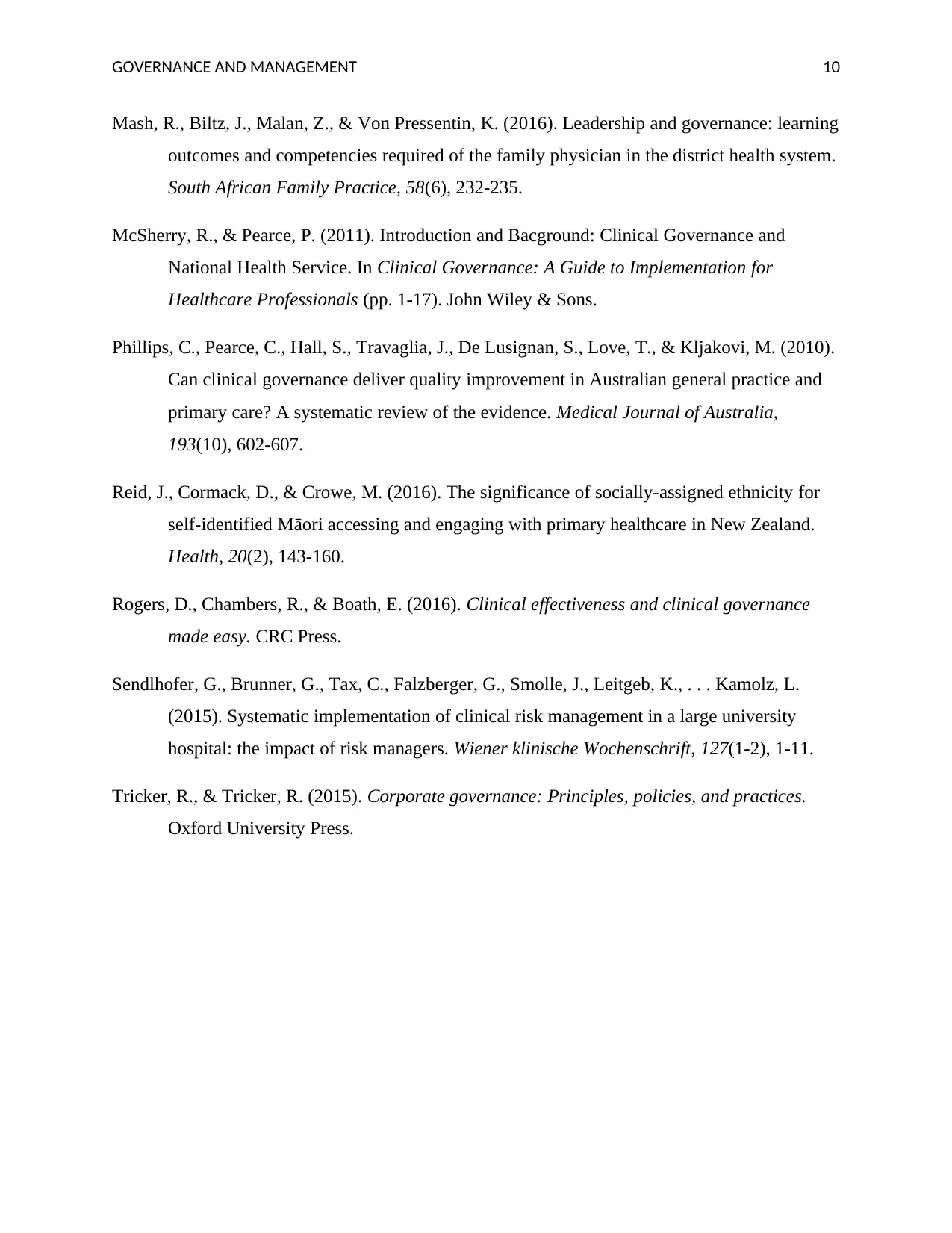
GOVERNANCE AND MANAGEMENT 10
Mash, R., Biltz, J., Malan, Z., & Von Pressentin, K. (2016). Leadership and governance: learning
outcomes and competencies required of the family physician in the district health system.
South African Family Practice, 58(6), 232-235.
McSherry, R., & Pearce, P. (2011). Introduction and Bacground: Clinical Governance and
National Health Service. In Clinical Governance: A Guide to Implementation for
Healthcare Professionals (pp. 1-17). John Wiley & Sons.
Phillips, C., Pearce, C., Hall, S., Travaglia, J., De Lusignan, S., Love, T., & Kljakovi, M. (2010).
Can clinical governance deliver quality improvement in Australian general practice and
primary care? A systematic review of the evidence. Medical Journal of Australia,
193(10), 602-607.
Reid, J., Cormack, D., & Crowe, M. (2016). The significance of socially-assigned ethnicity for
self-identified Māori accessing and engaging with primary healthcare in New Zealand.
Health, 20(2), 143-160.
Rogers, D., Chambers, R., & Boath, E. (2016). Clinical effectiveness and clinical governance
made easy. CRC Press.
Sendlhofer, G., Brunner, G., Tax, C., Falzberger, G., Smolle, J., Leitgeb, K., . . . Kamolz, L.
(2015). Systematic implementation of clinical risk management in a large university
hospital: the impact of risk managers. Wiener klinische Wochenschrift, 127(1-2), 1-11.
Tricker, R., & Tricker, R. (2015). Corporate governance: Principles, policies, and practices.
Oxford University Press.
Mash, R., Biltz, J., Malan, Z., & Von Pressentin, K. (2016). Leadership and governance: learning
outcomes and competencies required of the family physician in the district health system.
South African Family Practice, 58(6), 232-235.
McSherry, R., & Pearce, P. (2011). Introduction and Bacground: Clinical Governance and
National Health Service. In Clinical Governance: A Guide to Implementation for
Healthcare Professionals (pp. 1-17). John Wiley & Sons.
Phillips, C., Pearce, C., Hall, S., Travaglia, J., De Lusignan, S., Love, T., & Kljakovi, M. (2010).
Can clinical governance deliver quality improvement in Australian general practice and
primary care? A systematic review of the evidence. Medical Journal of Australia,
193(10), 602-607.
Reid, J., Cormack, D., & Crowe, M. (2016). The significance of socially-assigned ethnicity for
self-identified Māori accessing and engaging with primary healthcare in New Zealand.
Health, 20(2), 143-160.
Rogers, D., Chambers, R., & Boath, E. (2016). Clinical effectiveness and clinical governance
made easy. CRC Press.
Sendlhofer, G., Brunner, G., Tax, C., Falzberger, G., Smolle, J., Leitgeb, K., . . . Kamolz, L.
(2015). Systematic implementation of clinical risk management in a large university
hospital: the impact of risk managers. Wiener klinische Wochenschrift, 127(1-2), 1-11.
Tricker, R., & Tricker, R. (2015). Corporate governance: Principles, policies, and practices.
Oxford University Press.
1 out of 11
Related Documents
Your All-in-One AI-Powered Toolkit for Academic Success.
+13062052269
info@desklib.com
Available 24*7 on WhatsApp / Email
![[object Object]](/_next/static/media/star-bottom.7253800d.svg)
Unlock your academic potential
Copyright © 2020–2025 A2Z Services. All Rights Reserved. Developed and managed by ZUCOL.





